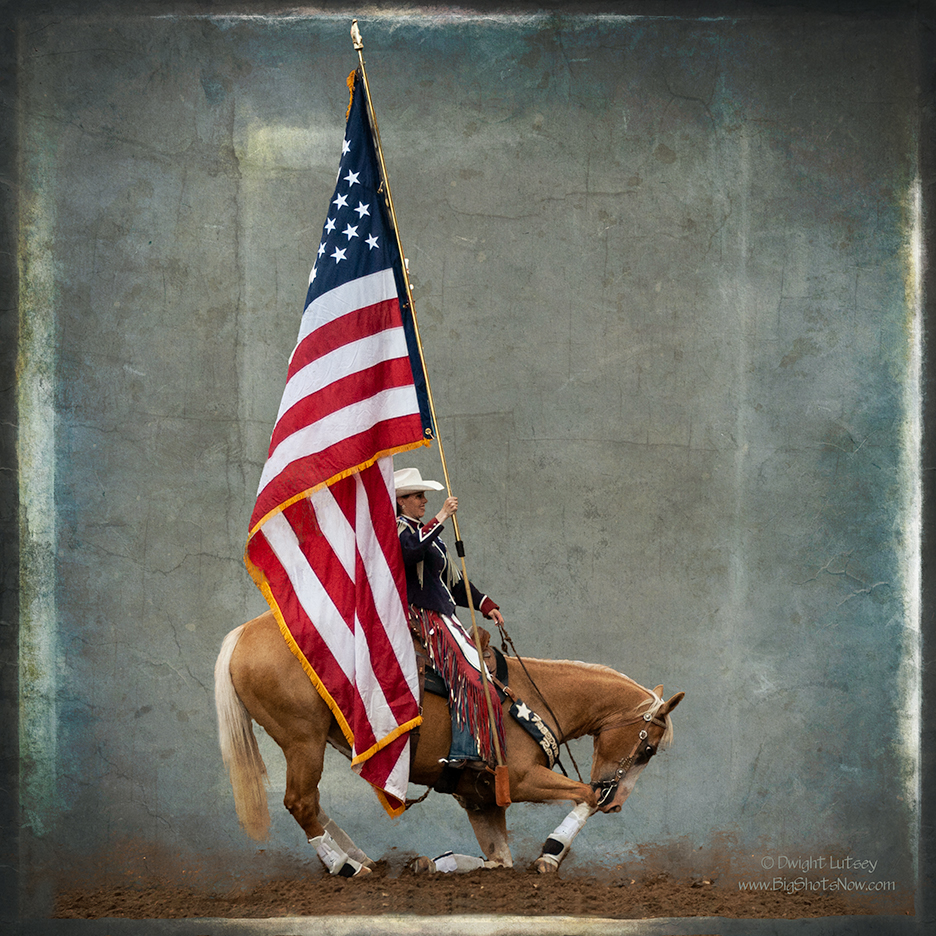
For All Those Who Served
We Salute You
And Thank You

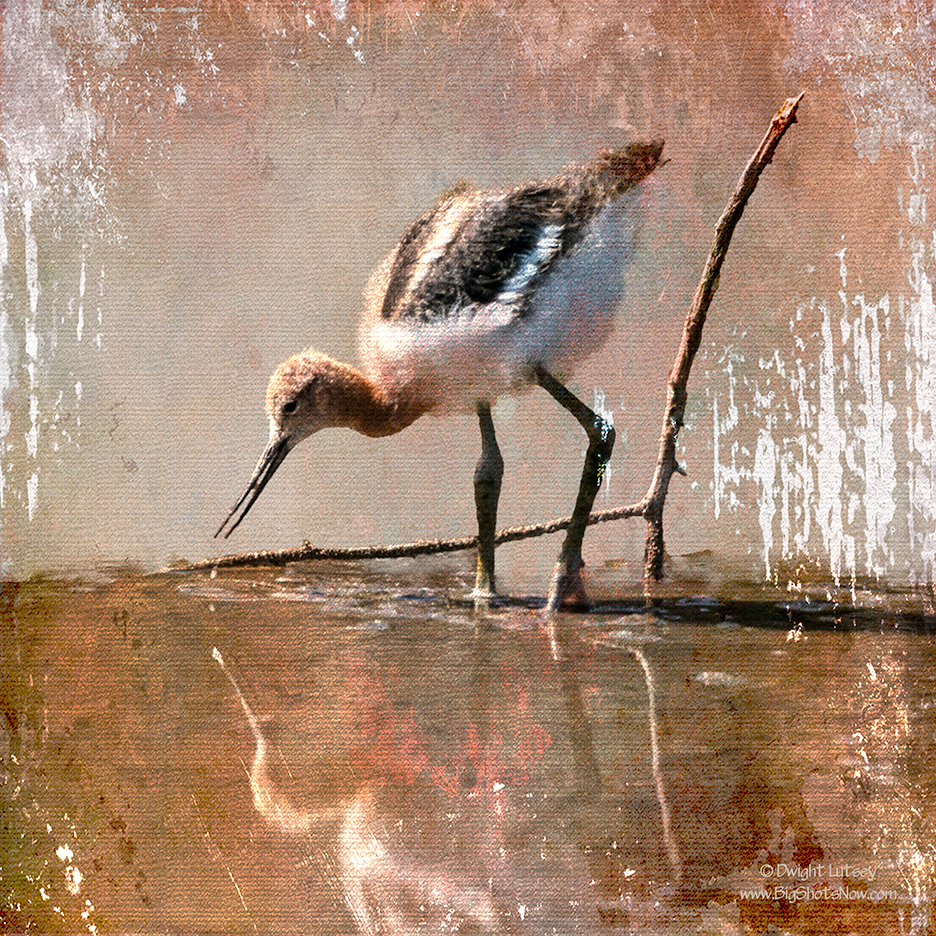
Birding is one if those things people do to get outside and commune with nature where many of the wild birds live. Their sole purpose is to look at those birds and say “I saw you, now I can go home and have a beer.” They make a list of all the different kinds of birds they’ve seen over the years and write them down in a little book, which is called their ‘Life List’. This is shown to other birders and gets them Street Cred in the “I saw a bird and you didn’t” world of birding.
This is not a sport for the uneducated. You can’t be stone cold dumb and be a birder. Many birders have attended highly prestigious places of edification where they don’t necessarily teach birding per se, but they do teach Latin which is used to name and classify bird species and confuse non Latin speakers. This makes the Latin user appear to be much brighter than the poor unwashed non Latin speaker and maintains the guild system that we Americans seem to love so much. It also keeps the rif-raf where they belong and the superior, well, superior. This system is primarily human based as the birds themselves couldn’t give a flying fig about what people call them. Except for peacocks, they are so vain.
One of the burning questions in the birding world is where to go to see birds. Where do they live? Are they accessible to Americans? Does one have to quarantine before looking at a bird? Can you see a bird if you don’t know its Latin name? What do they eat? Are they carnivorous? Do they favor the various root vegetables such as Rutabaga or Turnips? We know they don’t like Parsnips, nobody likes parsnips. These are just a few of the questions asked by people who don’t know any better but want to know so they can move up in the birding world.
One of the places where you can go and look at a bird is one of the various wildlife refuges. This is land that the government has deemed to be of absolutely no other use and therefore suitable to warehouse our excessive bird inventory. Species like those little brown birds you see pecking at everything everywhere. They’re all over the place. You’ve probably tripped over them. It’s very likely they have a Latin name of some sort but who knows what it is. Even if you heard it you wouldn’t know what it meant so one can safely discount and ignore them and go on to look at more interesting birds.
Bear River Migratory Bird Refuge near Brigham City, Utah is one of those holding pens where excess birds are held until they’re needed elsewhere. There you can see huge quantities of birds. They have them stacked all over the place. There are whole fields of those little brown birds spoken of before, which has been learned are actually a house sparrow or the Latin named Passer domesticus. There are great huge lumps of the White Faced Ibis piled willy nilly in unsightly stacks anywhere it’s wet. There you can select an assortment of birds for your own migratory bird refuge, if you have one. Way in the back of the refuge where it’s quieter, is an enormous area filled with lockers where larger birds such as the Tundra Swan are kept until it’s time to cut them loose and send them on up to the Tundra where apparently they are desperately needed at different times of the year.
One of the all time favorites for birders is the American Avocet. The image above is of a young Avocet or chick as they’re more vulgarly known. They look surprisingly like an adult Avocet only smaller. Its bill or beak has yet to grow into the graceful recurve that it uses to sweep through and syphon the water for its favorite food, the Rattle-back Shinsnuggler larvae which is only found here at the Bear River Migratory bird refuge. At least it is believed to be the Rattle-back Shinsnuggler larvae. There were no explanatory signs to indicate what the food is so an assumption was made which is believed to be close to what ever it is that the young Avocet or Chick is eating.
If you are interested in ‘Birding’ or its companion sport ‘Snake-ing’ you can contact any sporting goods store where they’ll sell you everything you might possibly need in the way of birding equipment. They also might tell you where to see birds but I wouldn’t count on that. However you already know where to go as you have just been told right here. It’s the Bear River Migratory bird refuge. So, Happy Birding then, and look down occasionally, that’s where the snakes are.
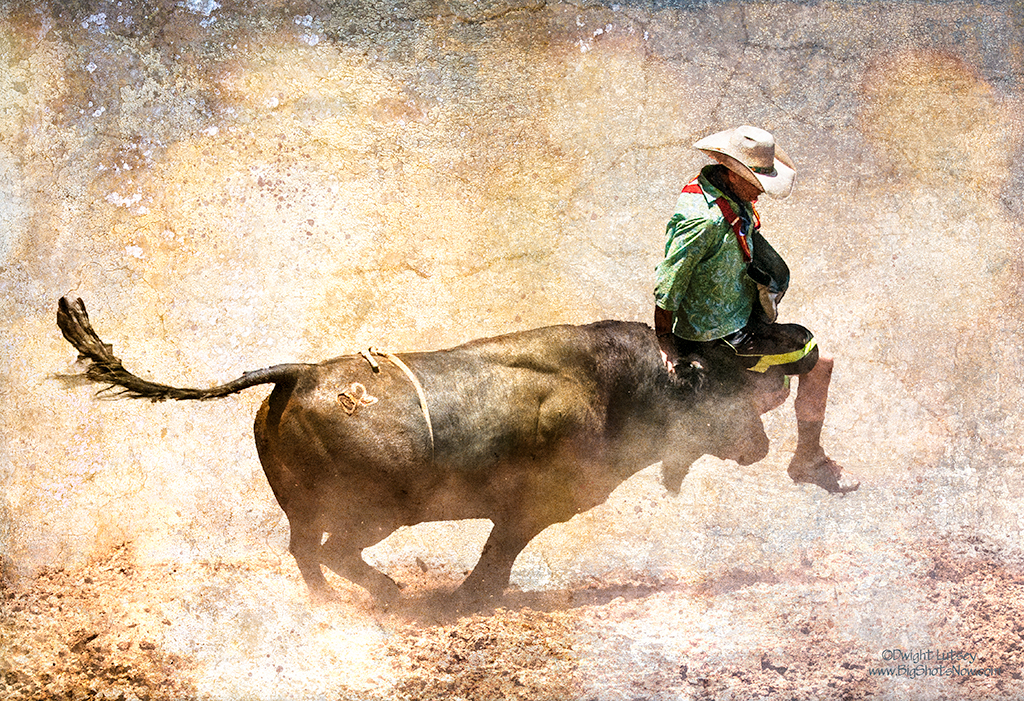
In the past we here at BigShotsNow.com have tried to bring you the newest, most up to date information about all things rodeo. We have told you about guys and sometimes girls that get on bucking broncos and try not to get bucked off. We’ve told you about great big guys that jump on little calves from their horses and wrestle them to the ground just to show they can. We’ve showed you pert but sassy cowgirls that race barrels for fun and profit, and even though the barrels don’t move, they, the pert and sassy cowgirls, win. We have even covered the occasional event where bulls, great big ferocious ones, are ridden by cowboys who have nothing better to do but test their major medical coverage.
But where we excel and you can ask anybody about this, is bringing you the newest most up to the minute news about new events in the competitive rodeo world. We’re talking brand new never before seen events that are changing the very face of todays rodeo.
Bull Steering is one of the newest events and by gad it’s a doozy. In fact, it is the newest event to try and interject some liveliness back into the old boring rodeo your grandma went to. It’s new! It’s exciting! It has the tantalizing elements of skill, danger, and uniqueness unseen until now! It is in fact, unbelievable. Plus it’s simple so neither the cowboys or the bulls need to be retrained to perform in this event. They can get together and just do it. Essentially it’s similar to bull riding but instead of getting on the bull’s back and hanging on while the bull tries to snap the cowboys head off, or he makes it to 8 seconds and completes the ride, the cowboy instead mounts and sits on top of the bull’s head as seen in the image above and grasping it’s horns rigidly but tightly, steers the bull around the arena by twisting, pushing and pulling on those horns causing the bull to trace out or walk through intricate patterns on the arena floor. Figures such as a simple circle, or perhaps a figure eight, or for those going for the big bucks, tracing the Texas star in the middle of the arena. This must all be done by the gentle nudging of the bull’s horns by the cowboy to direct the bull in the necessary direction to complete the pattern. Of course as in all rodeo events sometimes the bull doesn’t want to do it. Just says no and refuses. After all he doesn’t have to be there and due to his belligerent nature won’t participate. That ‘s when the rider needs to use all of his persuasive powers to crank those horns around and make that bull perform. Unlike the 8 second limit in the conventional bull riding event the rider and his bull have 15 minutes to complete a pattern to qualify. If the rider is thrown before that time limit, or the bull doesn’t execute a complete recognizable pattern then they are disqualified. Points are given according to the complexity of the pattern, quickness of completion, the congenial attitude or lack of it by the bull, and the cowboys ability not to faceplant in front of the bull and get stepped on, thereby disqualifying them both.
This event, “Bull Steering”, has never been seen yet in a PRCA rodeo or even some of the lesser known ones like Cheyenne Days or the Calgary Stampede. We found it at one of the smaller independent rodeos, “Stan and Molly’s Fudge Festival and Rodeo Day in Kerseyville, Nebraska. This wasn’t the biggest rodeo we’ve attended and the prize money was dependent on how much fudge Mary sold but it was a good one. Mary was nice, Stan could have been a little nicer but as he only had the one bull and he had to turn it around and get it ready for the next contestant all day long, he could be forgiven for being a little surly.
As always we try and present the newest things happening in the rodeo world before anyone else gloms on to it and spoils it by telling the truth and that’s just what we’ve done today. Here are a few of the other rodeo stories we were first on reporting. If you want to be ahead of your time and are on any of the major rodeo boards that schedule new events please contact us for leasing information. We represent Stan and Molly, well actually Molly as Stan is pretty hard to deal with. We believe this is an event the public should see.
http://www.bigshotsnow.com/horse-spinning
http://www.bigshotsnow.com/whoa-legless-bronco-busting/
http://www.bigshotsnow.com/dancing-with-the-bulls/
http://www.bigshotsnow.com/hang-time/.
http://www.bigshotsnow.com/sweet-nothings/
http://www.bigshotsnow.com/bull-riding-not-aways-a-love-story/
http://www.bigshotsnow.com/3-ways-to-get-a-bull-to-do-what-you-want/
http://www.bigshotsnow.com/the-mediator/
http://www.bigshotsnow.com/back-to-the-classics/
http://www.bigshotsnow.com/so-much-havoc-so-little-time/
http://www.bigshotsnow.com/red-chaps-in-the-sunset/
http://www.bigshotsnow.com/leaps-and-bounds-bull-riding-at-crow-fair-2018/
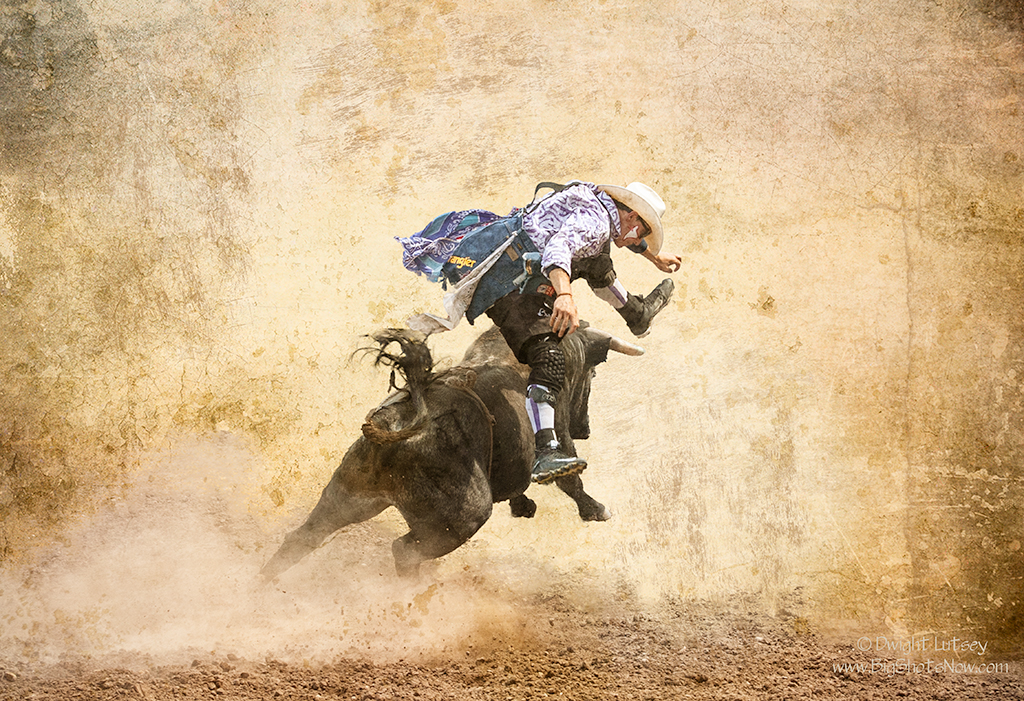
There is a phrase used fairly often, though not as much as it used to be, called Jumping the Shark. It loosely means something that was very popular and trendy that is now losing its popularity and beginning to fade away. TV shows that were ground breaking in some way, sensational due to their unusual and surprisingly defiant approach to current norms, now are becoming stale and outdated. The exact point where the decline started is where they jumped the shark and became irrelevant.
What we have here is a new phrase born out of the rodeo community, Jumping The Bull, which is the exact opposite of Jumping The Shark in every way. When you Jump the Bull you are doing something that is so extraordinary there is no chance that it will become dated or boring. You can watch that over and over and not get tired of it. When a two thousand pound ferocious and dangerous animal runs by you and you decide to jump over it knowing full well what the catastrophic consequences are if you screw it up, that’s Jumping The Bull.
The participants in this event are one of the rodeo clowns and his angry companion, an American fighting bull. Having just ejected his original rider and still filled with the blood lust of the battle, wanting nothing more than to destroy anyone near it, the bull races around the arena looking for anyone to vent its fury on, especially the fallen rider. It’s the rodeo clown’s job to keep it distracted while the original rider gets to safety. In this case the rodeo clown felt there was nothing left to do to get the animals attention but to jump over it. That may sound like the least likely approach to handle the situation but then this is not your normal situation. Anything goes in a deal like this. So the message here can be if you find yourself in a similar situation of being in a hot dusty arena with a maddened two thousand pound fighting bull charging down on you, well, simply jump over it and go get a coffee. It worked for this guy.
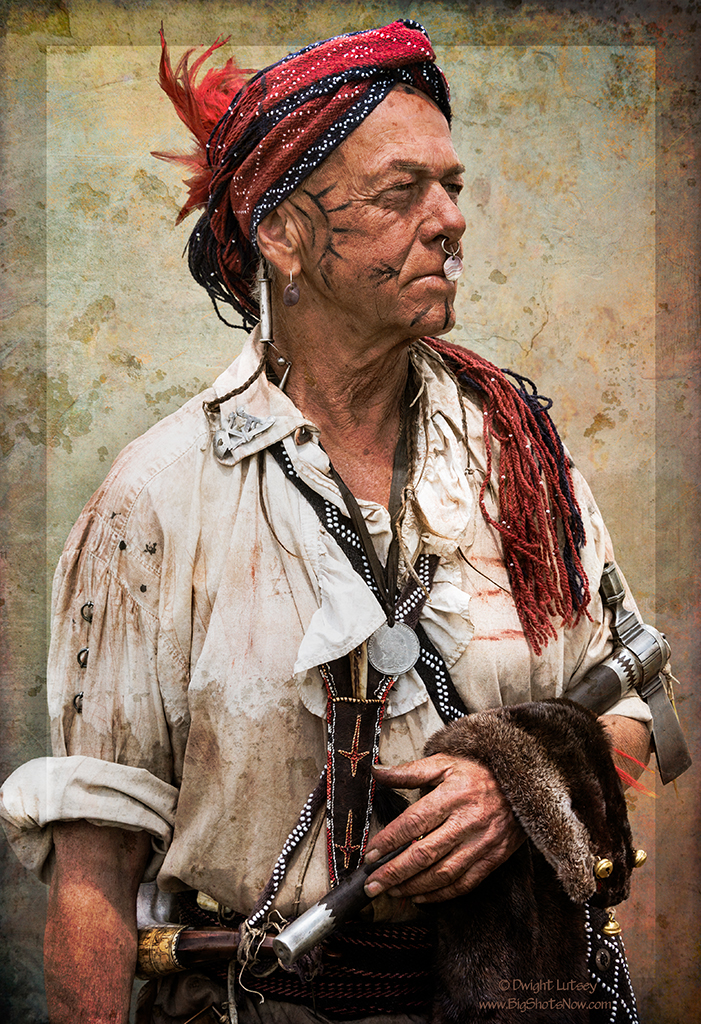
To borrow a title from the renown author Robert Heinlein, who we have here is another Stranger in a Strange Land. Like Valentine Michael Smith he is a traveler from a far off place brought from the land of the Iroquois to the furthest reaches of the West to attend a rendezvous in the 1830’s Rocky Mountains.
During the 1830’s it was extremely unusual to have a representative from one of the Eastern tribes be present at a rendezvous set in the area of the plains and inner mountain tribes. How he got there is due primarily to the fur trade. He was attached to the Hudson Bay fur company which was well established in the area where the Iroquois and other eastern tribes were settled. As the Hudson Bay company moved west he traveled with them. Upon reaching the mountains he deserted and joined up with a competitive American trapping party who took part in the rendezvous and so, was able to attend the event. He must have been a curiosity for the other attendees especially for the other tribes who very likely had never seen another Native American from a place over a thousand miles away to the East.
He is dressed in the style of his people at the time, circa 1760 and later, and his finery as he described it, includes a peace metal that was presented to the attendees of the Treaty of Easton by the Quaker parties. The earring and nose pendant are of the Quahog shells or Wampum. The turban, horn strap and bag are woven with the beads in the weave itself. The knife sheath is decorated with dyed porcupine quillwork. There are some trade silver brooches on the shirt and he is carrying an incredible *Presentation Pipe tomahawk forged from an old gun barrel. All in all an imposing figure.
The rendezvous were huge events for the mountain men and Indians of the Rocky mountains where they spent their time trapping furs throughout the year. It was their most important gathering where they could resupply, blow off some steam, and visit with old friends. And sometimes meet strangers from a strange land.
*The Incredible Presentation Pipe was actually made by the reenactor himself, Tortuga la Rouge, by forging it out of an old gun barrel. The skill that this took is amazing and reflects the lengths the participants of these events go to maintain authenticity and honor the traditions and customs of the people they represent.
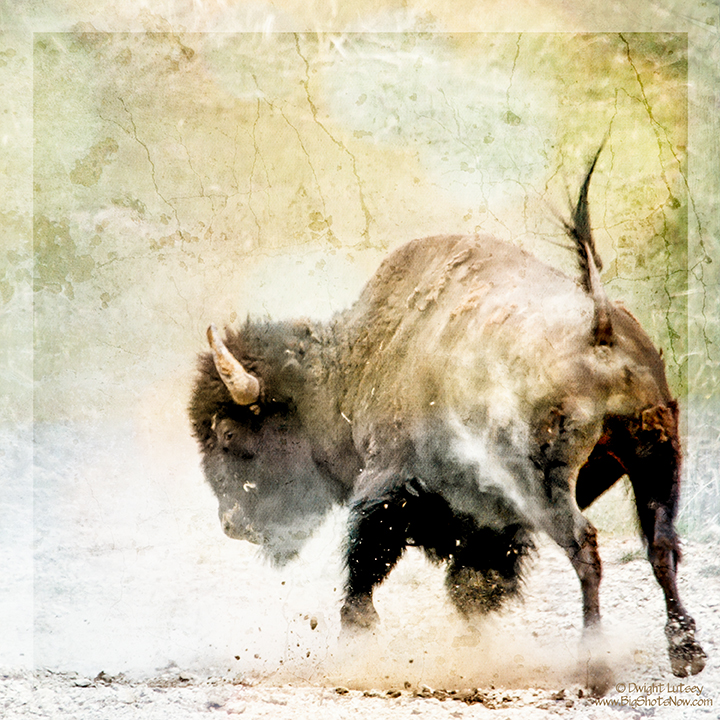
It’s summer and the the young buffalo are feeling itchy and out of sorts. Something’s coming up, they can feel it but don’t know what it is. All they know is they have to run around, and buck, and spin, and fall to their knees. Pushing their snouts in to the fresh dirt they’ve stirred up, and using their horns to tear up the ground is also on tap. If one of their herd mates is close by they might try and goad them into a sparring match but nothing too serious. The time for the real fighting is still a couple of months away. It’s the prelude to the Rut and these first timers are just at the mercy of their hormones.
The Rut is the breeding season for the buffalo and it is the largest event in their lives. The urge to breed is totally consuming and will occupy their time with fighting, chasing willing and unwilling cows, bellowing, kicking up dirt and dust and generally being swept up in the compulsive nature of their lives. This young buffalo used an old wallow as the center point of his frustration and danced and ran in circles around it and thru it and put on a spectacle that lasted until it was exhausted and finally collapsed to rest. To the observer it was dancing in the dust and for a large animal it was surprisingly graceful.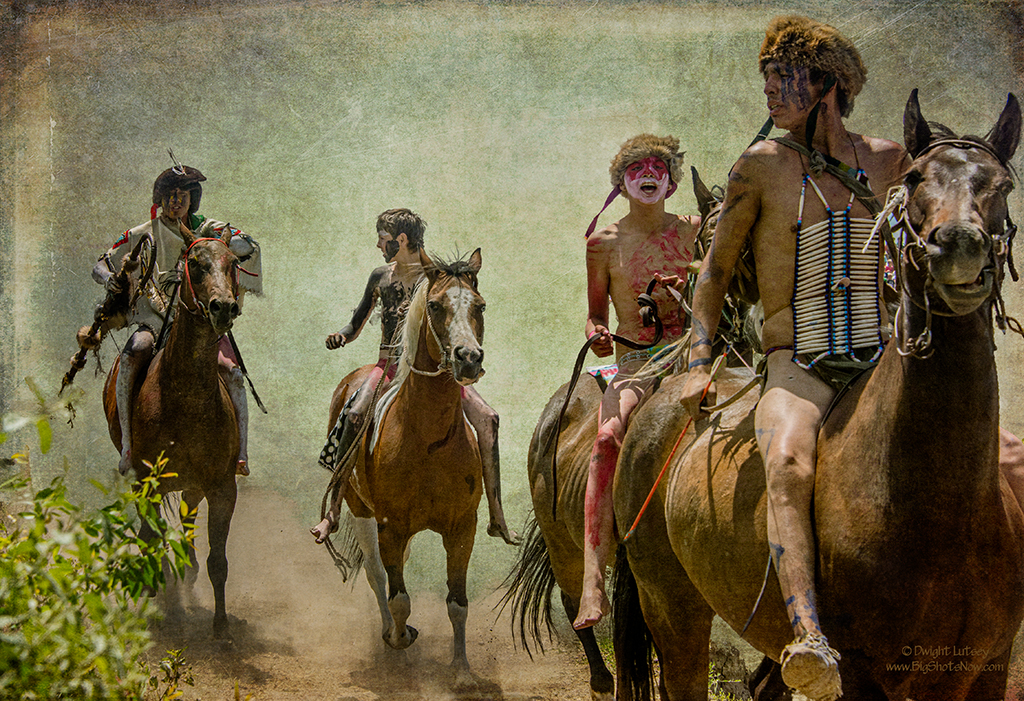
In the excitement of battle, the dust swirls up obscuring visibility, the sounds of the fighting seem to come from every direction, the eagerness on the part of these young men to enter the action, all play into the frenzy of making war. These young warriors are desperate to join the others and the fighting and are terrified they won’t get to take part in it before its over. The possibility to leave their youth behind and enter manhood as a respected battle proven warrior is their single driving force. This is their chance to make a name for themselves and gain honor by engaging the enemy. If they can only find them.
The battle is spread over a large area and the different engagements that make it up are constantly moving as fortunes shift and events unfold. It can be confusing trying to enter the action especially if your desire is to get up close to the enemy so you can fight them face to face, thereby winning much honor and the right to boast of your prowess to anyone who will listen. To be taken seriously as warriors not just untested young men. A very important thing to young men trying to move up in the warrior society. Every opportunity missed is an obstacle to their advancement.
As destiny would have it these young men barely out of their childhood will find the battle, and will find out what their future holds. Only the gods of war know what that future is.
You must be logged in to post a comment.